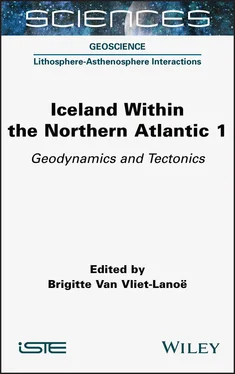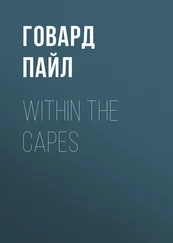Brigitte VAN VLIET-LANOË and Françoise BERGERAT
This collective work is the logical conclusion of more than 30 years of French research in Iceland, with the support of various programs and institutions. It has also benefitted from the contribution of a CNRS Thematic School on Iceland, which was held in Brest in 2010 and which was strongly impacted by the eruption of Eyjafjallajökull. This book is the fruit of the work of a group of complementary researchers who are very fond of Iceland. Our thoughts turn to Jacques Angelier who left this basaltic ship a little too early. There are multiple authors to each chapter – with a principal author for each one – in order to provide a multidisciplinary approach to the discussed scientific problems and take into account all our publications up to the most recent ones (2019–2020).
French research in Iceland began in the mid-1980s, initiated by Françoise Bergerat (Sorbonne Université, formerly Université Pierre et Marie Curie, in Paris) in search of an “emerging oceanic ridge”, in collaboration with Jacques Angelier†, then Catherine Homberg. Very quickly, this collaboration was extended to Icelandic colleagues, Águst Guðmundsson (London), Kristjan Sæmundsson, Ragnar Stefánsson and Sigurdur Rögnvaldsson †. The first work focused on the analysis of brittle deformations and then turned to sismotectonics.
This work was then supplemented, from the 2000s, by the geodetic campaigns of the team from the Université de Savoie in Chambéry led by Thierry Villemin in collaboration with Halldór Geirsson and his group. At the beginning of the 1990s, Laurent Geoffroy began (in Paris) work on the Thule basaltic provinces (Scotland, Ireland, Faroe Islands), continued from the 2000s (at the Université du Maine, in Le Mans) on the other side of the Atlantic, in Greenland. The analysis of the morphology of Iceland began in the mid-1990s at the Université de Rennes-I, with Olivier Dauteuil and Brigitte Van Vliet-Lanoë, and then extended to the neighboring ocean in relation to volcanism and the evolution of the North Atlantic. At the same time, the Neogene and Quaternary climatic history of the island, recorded by stratigraphy, was consolidated with dating carried out by Hervé Guillou and his colleagues and by geochemistry carried out at the Université de Bretagne Occidentale, in Brest, in close collaboration with Águst Guðmundsson (Hafnafjördur), Kristjan Sæmundsson and Helgi Björnsson’s team. The last stage of this work is currently being developed in the Géosciences Océan laboratory in Brest, with Laurent Geoffroy and René Maury. It concerns the evolution of the North Atlantic based on Icelandic and Greenlandic data.
The material and logistical support of the Icelandic authorities proved to be very constructive both for field work and for data acquisition and sharing: IMO (Veðurstofa Íslands/Icelandic Meteorological Office); ISOR (Íslenskar orku-rannsóknir/Icelandic energy research), formerly Orkustofnun (National Energy Authority); Landsvirkjun (National Power Company) and Vatnajökull National Park. This research would not have been as fruitful without the physical and intellectual help of all our students, at Master’s level and/or with their thesis works: Olivier Bourgeois, Magalie Bellou, Jean-Christophe Embry, Loïc Fourel, Sebastian Garcia, Guillaume Gosselin, Solène Guégan, Romain Plateaux, Lionel Sonnette, Anne Sophie Van Cauwenberge, Ségolène Verrier and Audrey Wayolle.
Finally, this work was made possible because of the assistance of the French Embassy in Iceland and funding from the European Commission, 4th and 5th PCRD (PRENLAB-1 and -2, PREPARED and SMSITES programs); the Paul Émile Victor Institute (IPEV), formerly the Institut français pour la recherche et la technologie polaires (IFRTP) (Arctic Program 316); the Icelandic Ministry of Education; and the French Ministry of Foreign Affairs (Franco-Icelandic scientific and cultural collaboration program).
We also thank Bernadette Coleno, Marion Jaud, Laurent Gernigon and Alexandre Lethiers for their contributions to the figures in this volume.
February 2021
Brigitte VAN VLIET-LANOË and René MAURY
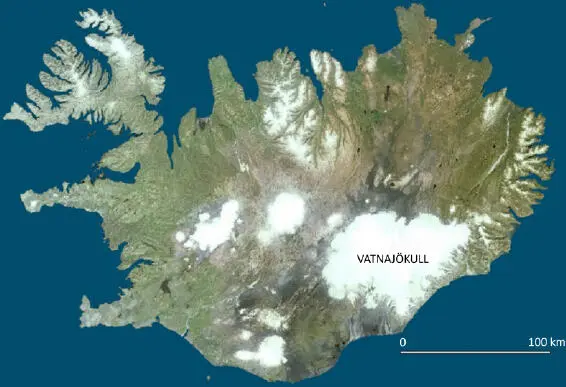
Figure I.1. Iceland from Space (document Geographical Institute of Iceland/Landmælingar Ísland [LMIs])
Iceland ( Figure I.1), a young and isolated island in the middle of the Atlantic Ocean, has only very recently been discovered in terms of the scale of human history. Irish monks (the papars) passed from island to island in their curraghs ( Figure I.2) via the Shetland Islands and the Faroe Islands to evangelize the legendary Hyperborea. These journeys took place as early as the 6th century, a period with cold volcanic winters.
The papars discovered a world of fire and ice, the gates of hell. They settled in round peat-covered huts and dug shovel caves in the consolidated sandy interglacial formations in the south of the island.
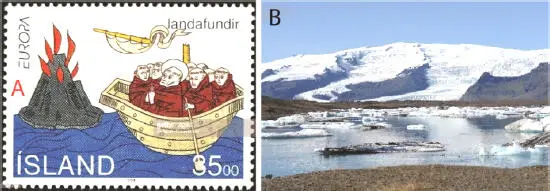
Figure I.2. (A) Icelandic stamp illustrating the discovery of Iceland by Irish monks (papars). (B) The glacial lake Jökulsarlón dominated by the volcano Oræfajökull (Brigitte Van Vliet-Lanoë©)
Two hundred years later, the Vikings, warriors but also more than anything farmers in search of cultivable land ( Figure I.3), settled in the south and west of the island from 860 AD on wooded land made fertile by thick layers of volcanic loess. This is the landmana of the Icelandic sagas. They installed their parliament, the Alþing, around 900 AD, in a remarkable site ( Figure I.4), which became a high place of plate tectonics, the Þingvellir graben, the boundary between the European and American plates.
These fertile lands were surmounted for at least 400,000 years by a fire monster, the Hekla volcano ( Figure I.5). Its Plinian eruption in 1104 AD (H1, volcanic explosivity index of 5) destroyed many Viking settlements in the Rangavellir, not only by falling pumice and gas but also by the associated glacial megafloods, the jökulhlaups , submerging the Þjorsárdalur with a wave of muddy water more than 25 m high. At that time, the Hekla must have been more ice-covered than it is today.
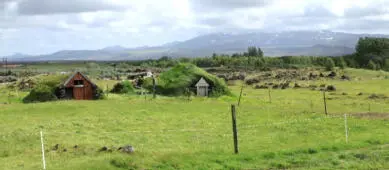
Figure I.3. Traditional sheepfolds in southern Iceland with the volcano Hekla in the background (Rangavellir) (Brigitte Van Vliet-Lanoë©)
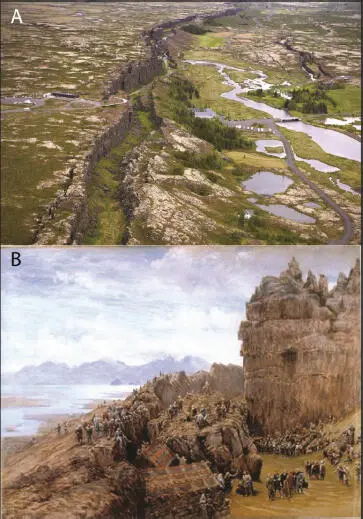
Figure I.4. (A) The Þingvellir graben, seen from an airplane (Þingvellir National Park Web site). The Alþing site is located in front of the white buildings (chapel). (B) Reconstruction of the Alþing in the Middle Ages by W.G. Collingwood (1897)

Figure I.5. (A) The Hekla volcano (Brigitte Van Vliet-Lanoë©) and (B) its cartographic representation on the map Islandia of Ortelius (1585)
Читать дальше
